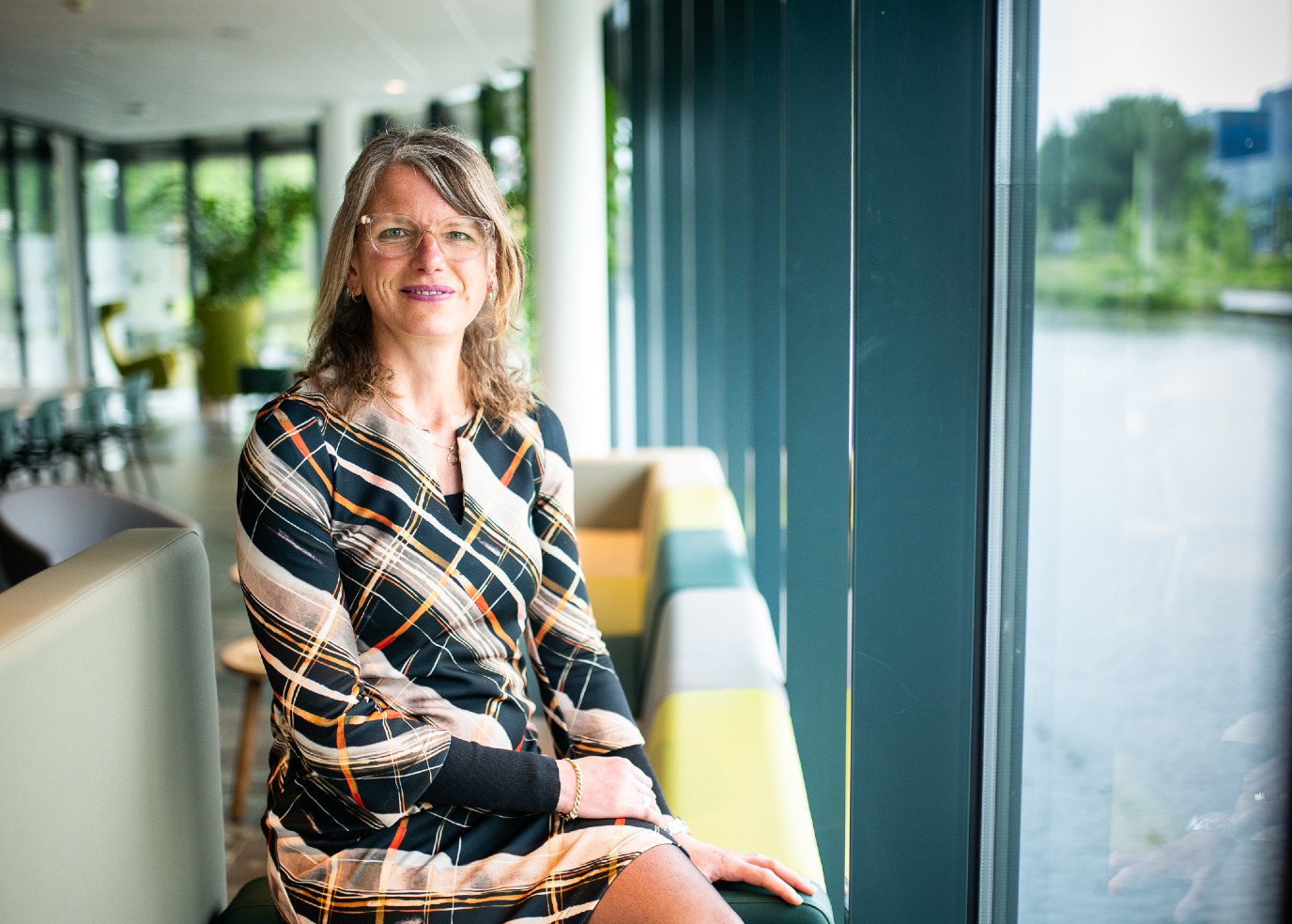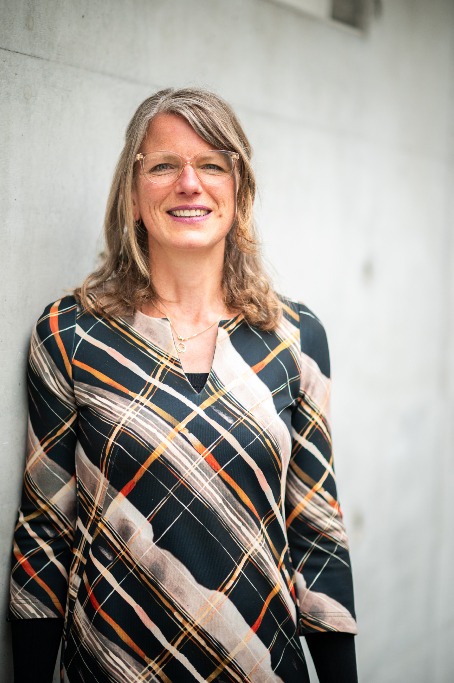Director CIT: ‘Digitisation is not merely a tool, but a goal in itself’

Technology and digitisation play an ever greater role in society, says Nolda Tipping-Griffioen, Director of CIT and Chief Information Officer at the University of Groningen. According to her, it calls for a leading role of the university. As such, she stresses the importance of cooperation with the Jantina Tammes School for Digital Society, Technology and AI.
Text: Jelle Posthuma
Combining technology and organisations: this is the common thread in Nolda Tipping-Griffioen's career. In the summer of 2024, she started as director at the Center for Information Technology (CIT) at the University of Groningen. She previously worked for several years at Shell in various countries and positions, and was director ICT and Chief Technology Officer at the Dutch Ministry of Education, Culture and Science's Dienst Uitvoering Onderwijs (DUO).
Not a tool, but a goal
Tipping-Griffioen combines her role as CIT director with the position of Chief Information Officer (CIO). By now, she has been working at the university for over half a year. 'CIT is largely about continuity, taking care of the organisation and services. My role as CIO is more strategic: where do we want to go as a university in terms of digitisation? And what role will AI play in this, for example?'
As CIO, Tipping-Griffioen aims to guide the university's digital transformation. She argues that the UG could be more responsive to societal developments, where digital technology plays an increasingly important role. ‘At the UG, IT is often still seen as a tool rather than a goal in itself,’ she explains. ‘In terms of expertise, we already have the crème de la crème. However, I observe that the central role of technology has yet to fully permeate the university. Technology and IT are not just peripheral concerns; it’s not about having a laptop and functioning Wi-Fi – it is about making technology the core of our organisation. It's also the kind of knowledge and skills we want to equip every student with.’
The CIT director highlights the need for investment in IT infrastructure. ‘I often find myself explaining to others why IT investments are vital for the university,’ she says. ‘IT maintenance is already expensive, and these costs will only increase. However, the bigger risk of not investing is what we call a ‘vendor lock-in’, where only one provider is left to maintain outdated systems, often at exorbitant prices.’
Investments and low-hanging fruit
While investment is required, Tipping-Griffioen sees opportunities to better map the university’s IT infrastructure, enabling different departments and faculties to benefit from one another. ‘It’s not uncommon for multiple licences to be purchased for the same product. As CIT, we aim to gain a clearer overview of the various licences across the university. This requires centralisation and rationalisation. There is considerable low-hanging fruit in this area.’
The cyberattacks on Dutch universities also highlight the importance of investing in IT infrastructure and security, as Tipping-Griffioen is well aware. ‘If your IT systems fail, the entire organisation comes to a standstill. This is no different at the UG.’ As CIT director, she aims to pinpoint exactly where the vulnerabilities lie. ‘For example, who holds the ‘plug mandate’ within the various faculties and services: who has the authority to cut off access in the event of a critical cyberattack?’
Collaboration Jantina Tammes School
In addition to cybersecurity, artificial intelligence (AI) is also drawing significant attention. In the field of AI, Tipping-Griffioen’s focus is primarily on fostering collaboration. The UG is decentralised, but cooperation in the field of AI requires a place where it all comes together. She mentions setting up a central ‘desk’ and a knowledge guild for sharing good ideas, for instance on ‘compliance’ (regulations) regarding AI. ‘For example, what do we do with the AI Act, the new regulations coming from the European Union?’
For the knowledge guild, collaboration with the Jantina Tammes School (JTS) is an obvious choice, says the CIT director. ‘The School is a place where like-minded individuals can share what they’re working on. In fact, that’s half the job.’ She reflects aloud, ‘Perhaps it should become something like a Reddit page, where people can ask questions and help each other.’ Tipping-Griffioen sees further opportunities for collaboration with the JTS. ‘The School is well positioned to shape, inspire, and connect a knowledge guild through its network. CIT can offer manpower, expertise, and potentially the more business-oriented aspects of AI development within the UG.’
Currently, there are existing collaborations between CIT and JTS in research, artificial intelligence, and high-performance computing (HPC). The School also works closely with the Geodienst. ‘There is an overlap in the areas the School, CIT, and I, in my role as Chief Information Officer, are involved in. However, we don’t compete with each other, because there’s so much to be done. We can strengthen each other by ‘passing on’ work when needed. Sometimes, things are a better fit for the School, and other times, they are better suited to CIT. That’s what I want to focus on in the future.’

Optimism
Above all, the CIT director and CIO aims to position the university at the forefront of AI. She believes it is not beneficial to keep artificial intelligence on the sidelines. ‘I tend to be on the optimistic side: aiming to harness the benefits of AI. For example, reviewing exams or handling repetitive manual tasks during research are areas where we can partly delegate work to AI, freeing up time for other activities.’
A common application of AI, used by both staff and students, is the so-called Large Language Models, with ChatGPT being the most well-known example. As part of a pilot project, Tipping-Griffioen is exploring whether the UG could purchase over 500 central licences for Le Chat (from the French company Mistral) in the near future, ensuring that data remains within the organisation. ‘The current use of AI comes with significant costs for paid versions, which creates inequality among students with limited funds. In an ideal world, we would be able to offer a licence to every UG student.’
A central discussion on the use of AI by students is also crucial, according to Tipping-Griffioen. ‘What do we allow our students to do, and how is it regulated across different faculties and at other universities? As a university, you can hardly ban it completely; I know that all too well with three teenagers at home,’ she laughs.
From the outside in
Above all, the CIT and CIO director aims to connect with what's going on in society, by working closely with the region. ‘Until now, we have been quite a ‘black box’ for the outside world. I try to look from the outside to the inside as much as possible: what do students and society need, and what can we offer as a university? In this regard, digitisation and technology are essential. By now, industry has realised this central role. It is important that we as a university do not miss this opportunity, so that we remain relevant to the new generation of students.’
According to her, it requires collaboration between faculties and a central role for digitisation. While many conversations are taking place, Tipping-Griffioen argues that action is still lacking. ‘It calls for bold decision-making. We can only accelerate digitisation as a whole. I would like digitisation to be at the heart of the university, because it is needed everywhere.’
Tipping-Griffioen sees opportunities for collaboration with the Jantina Tammes School in this area as well. ‘The School operates effectively from the outside in, being visible and acting as a bridge to society. Furthermore, the JTS holds a central position between the faculties and shares a similar mission in the field of digitisation. We have the ‘manpower’ and expertise, and in that, we can complement each other very well.’
Jantina Tammes School for Digital Society, Technology & AI
The Jantina Tammes School (JTS) is the interdisciplinary platform with a focus on digital society, technology and artificial intelligence (AI). The JTS is one of the four Schools for Science and Society of the University of Groningen, addressing societal issues together with the public, educational institutions, governments and industry.
| Last modified: | 03 April 2025 1.14 p.m. |
More news
-
24 March 2025
UG 28th in World's Most International Universities 2025 rankings
The University of Groningen has been ranked 28th in the World's Most International Universities 2025 by Times Higher Education. With this, the UG leaves behind institutions such as MIT and Harvard. The 28th place marks an increase of five places: in...
-
05 March 2025
Women in Science
The UG celebrates International Women’s Day with a special photo series: Women in Science.
-
16 December 2024
Jouke de Vries: ‘The University will have to be flexible’
2024 was a festive year for the University of Groningen. In this podcast, Jouke de Vries, the chair of the Executive Board, looks back.

